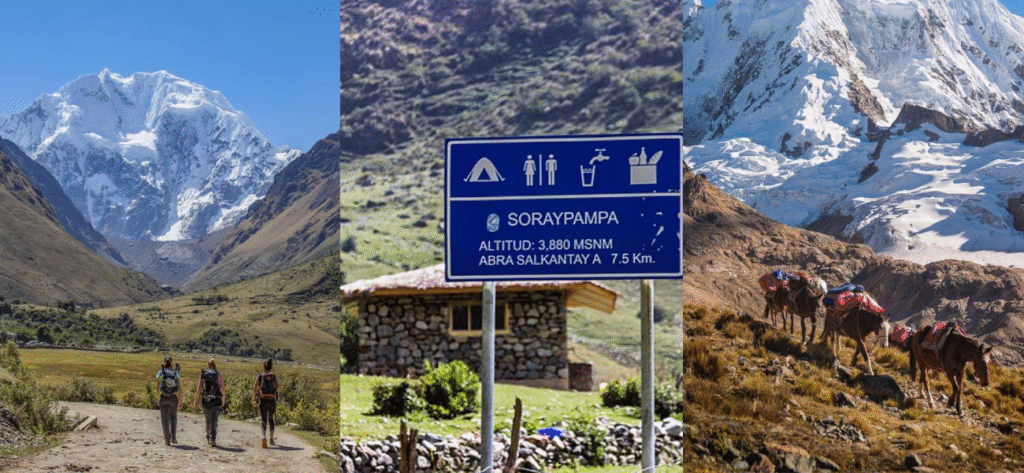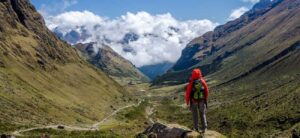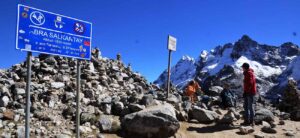What Every Hiker Should Know
The Salkantay Trek to Machu Picchu is one of the most breathtaking adventures in Peru — but if you’re planning your trip, it’s natural to wonder:
Is the Salkantay Trek dangerous?
The short answer is: not if you’re prepared. Like any high-altitude trek, it comes with challenges, but with the right preparation and guidance, thousands of people safely complete it every year. Let’s take a closer look at the real risks and how to stay safe on the trail.
Altitude: The Biggest Challenge
The highest point on the Salkantay Trek is Salkantay Pass at 4,650 meters (15,256 feet). At this altitude, the air is thin, and some hikers experience altitude sickness (headaches, nausea, shortness of breath).
How to stay safe:
- Spend 2-3 days in Cusco before your trek to acclimatize.
- Stay hydrated and avoid alcohol.
- Ascend slowly and pace yourself on the trail.
- Talk to your doctor about altitude medication.
Weather Conditions
The Salkantay Trek crosses diverse climates: from freezing mountain passes to humid cloud forests. Sudden weather changes can make the trail slippery or cold.
How to stay safe:
- Pack for all conditions: layers, rain gear, gloves, and sun protection.
- Avoid trekking during the rainy season (January to March) when trails can be muddy and risky.
- Listen to your guide’s advice about daily conditions.
Trail Difficulty and Terrain
The trek is considered moderate to challenging. You’ll face steep climbs, long walking days, and uneven terrain.
How to stay safe:
- Choose a trek length that matches your fitness level (there are 4-day and 5-day options).
- Use trekking poles to reduce strain on knees and for stability.
- Wear proper hiking boots with good grip.
Wildlife and Natural Risks
Encounters with wildlife are rare and usually harmless. However, like any trek, you should be mindful of:
- Insects (use repellent)
- Avoid touching plants you don’t recognize
- Be cautious around rivers and steep drops
Travel with a Licensed Tour Operator
One of the best ways to minimize risks is to trek with a reputable tour company. Guides are trained in first aid and altitude management, and they’ll monitor your health throughout the journey.
Final Verdict: A Safe Adventure for Prepared Travelers
So, is the Salkantay Trek dangerous?
It’s challenging — but safe if you come prepared and take precautions.
Thousands of hikers from around the world successfully complete the trek every year, rewarded with stunning mountain views and the unforgettable arrival at Machu Picchu.
With the right mindset, preparation, and a good guide, you’ll conquer the trail and create memories for a lifetime.
What you should do before booking Salkantay Trek to Machu Picchu
1. What is the Salkantay Trek, and how does it compare to the Inca Trail?
The Salkantay Trek is an alternative route to Machu Picchu, offering breathtaking landscapes, including snow-capped mountains, cloud forests, and high-altitude passes. Unlike the Inca Trail, the Salkantay Trek does not require a permit and is less crowded, providing a more adventurous experience.
2. How many days does the Salkantay Trek take to reach Machu Picchu?
The standard Salkantay Trek takes 5 days and 4 nights, covering approximately 72 km (45 miles). However, there are shorter and longer variations of the trek available.
3. What is the difficulty level of the Salkantay Trek?
The Salkantay Trek is considered moderate to challenging, as it involves hiking at high altitudes and steep ascents. The highest point is the Salkantay Pass at 4,650 m (15,255 ft). Proper acclimatization is recommended before starting the trek.
4. Do I need a permit to hike the Salkantay Trek?
No, unlike the Inca Trail, the Salkantay Trek does not require a special permit. However, you do need an entrance ticket for Machu Picchu, which should be booked in advance.
5. What is the best time of year to hike the Salkantay Trek?
The best time to hike the Salkantay Trek is during the dry season (April to October). The weather is more stable, with clear skies and less rain. The rainy season (November to March) can make the trail muddy and challenging.
6. What should I pack for the Salkantay Trek?
Essential items include:
- Hiking boots (waterproof and comfortable)
- Warm layers (temperatures drop at night)
- Rain jacket or poncho
- Sleeping bag (suitable for cold weather)
- Sun protection (hat, sunglasses, sunscreen)
- Water bottle and purification tablets
- Basic first aid kit
7. Is altitude sickness a concern on the Salkantay Trek?
Yes, altitude sickness can be an issue, especially at the Salkantay Pass (4,650 m). It is recommended to spend a few days in Cusco (3,400 m) before the trek to acclimatize. Staying hydrated, avoiding alcohol, and chewing coca leaves can help with symptoms.
8. How do I get to Machu Picchu from the end of the Salkantay Trek?
After reaching Hidroelectrica, you have two options:
- Hike 3 hours to Aguas Calientes.
- Take a 30-minute train from Hidroelectrica to Aguas Calientes.
From Aguas Calientes, you can hike or take a bus up to Machu Picchu.
9. Are there accommodation options along the Salkantay Trek?
Yes, most trekking companies provide campsites or eco-lodges along the route. Some upgraded tours offer more comfortable accommodations, such as glass cabins or domes. The final night is usually spent in a hotel in Aguas Calientes.
10. Can I visit Machu Picchu without hiking the Salkantay Trek?
Yes, you can take a train from Cusco to Aguas Calientes, followed by a short bus ride or hike up to Machu Picchu. This is the most popular option for visitors who prefer not to hike.
You must be interested
- Salkantay Trek to Machu Picchu
- Salkantay Trail 5 days 4 nights
- Salkantay Trek difficulty level
- Salkantay vs Inca Trail comparison
- Best time to hike Salkantay Peru
- Salkantay Trek tour price 2026
- Guided Salkantay Trek packages
- Salkantay Trek altitude and acclimatization
- Salkantay Trekking tours from Cusco
- Salkantay Trek full itinerary
Salkantay Travel Information
- Salkantay Trek Food: What You’ll Eat on the Trail
- Birds of the Salkantay Trek: Species You Can Spot on the Route
- Is the Salkantay Trek Dangerous?
- Salkantay Trek Altitude: Heights Along the Route
- Flora and Fauna in Salkantay Trek
- Altitude Sickness on the Salkantay Trek
- Salkantay Trek Difficulty: How Hard Is the Route?
- Salkantay Trek FAQs: Answers to Common Questions
- Best Time to do Salkantay trek
- Training for Salkantay Trek: How to Get Ready
- How long is the Salkantay Trek?
- Salkantay Trek Price: How Much Does It Cost?
- What Is the Salkantay Trek?
- What to Bring on the Salkantay Trek?
- Best Time to Do Salkantay Trek
- Your Insider’s Guide to Salkantay Trek
- Where is Salkantay?
- Salkantay highlights
- Tour Montaña de Colores con Transporte














